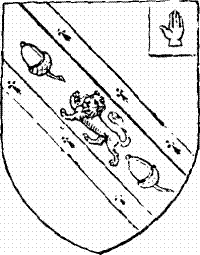Francis Rodes
| Francis Rodes | |
|---|---|
 Arms from Magna Britannia[1] | |
| Born |
c. 1530[2] Staveley Woodthorpe, Derbyshire, England |
| Died |
1588 Staveley Woodthorpe |
| Education | St. John's College, Cambridge |
| Occupation | Judge |
| Spouse(s) | Elizabeth Sandford and Mary Charlton |
| Children | yes |
| Parent(s) | John Rodes |
Sir Francis Rodes (c. 1530–1588) was an English judge, the son of John Rodes of Staveley, Derbyshire, by his first wife, Attelina Hewett of the West Riding of Yorkshire. He took part in the trial of Mary, Queen of Scots, built Barlborough Hall, and he was one of the founders of Netherthorpe School.
Biography
The family traced its descent from Gerard de Rodes, a prominent baron in the reign of Henry II. Francis was educated at St. John's College, Cambridge, but did not graduate.[3] In 1549, he was entered at Gray's Inn,[4] and in 1552, he was called to the bar. He was Lent Reader at his inn in 1566, and double reader in 1576, and seems to have derived a considerable fortune from this practice. In 1577, Rodes had bought the manor of Hanley (in Steveley) from Edmund West.[5]

In 1578, he was raised to the degree of the coif, and on 21 August 1582[4] he was made queen's Serjeant. On 29 June 1585, he was raised to the bench as justice of the common pleas, and in October 1586, he took part in the trial of Mary, Queen of Scots, at Fotheringay, thought not as one of the main judges.[2] He died towards the end of 1588 at Staveley Woodthorpe. His will, dated 7 June 1587, was proved on 28 April 1591; among numerous other benefactions he made bequests to St. John's College, Cambridge, and the newly founded the grammar school Netherthorpe School. His 'Reports' were among the manuscript collections of Sir John Maynard (1602–1690), and are now in the Lincoln's Inn library [6] His principal seat was at Barlborough, Derbyshire, where he built Barlborough Hall, which is still standing; he also purchased extensive estates at Billingsley, Darfield, Great and Little Houghton, all in Yorkshire.[2]
Family
Rodes married, first, Elizabeth Sandford of Thorpe Salvine, Yorkshire; and, secondly, Mary Charlton of Apley in Shropshire. Her sister Elizabeth married John Manners, 4th Earl of Rutland, who appointed Rodes one of his executors.[7]
Legacy
A quote from an 1857 directory:
Netherthorpe School.—Francis Rodes, by will, 29th of Elizabeth, left a yearly rent charge of £20 per annum, to be taken forth of his manor of Elmton; £8 thereof to the Grammar school, at Staveley Netherthorpe, £8 for two scholarships in St John's College, Cambridge, and £4 for the relief of soldiers who should be sent to the wars out of Staveley, Barlborough, and Elmton.[5]
Francis' gifts when combined with others from the Duke of Devonshire, Robert Sitwell and a local minister enabled the school to have an annual income of £29.[5]
Rodes was succeeded in the Barlborough estates by his eldest son, Sir John Rodes (1562–1639), whose son Francis (died 1645) was created a baronet on 14 August 1641. The title became extinct on the death of Sir John Rodes, fourth baronet, in 1743. See Rodes Baronets.
Darfield and Great Houghton passed to the judge's eldest son by his second wife, Sir Godfrey Rodes (died 1634), whose son, Sir Edward Rodes (1599–1666), served as High Sheriff of Yorkshire and colonel of horse under Oliver Cromwell; he was also a member of Cromwell's privy council, High Sheriff of Perthshire, and represented Perth in the parliaments of 1656–1658 and 1659–1660. Sir Edward's sister Elizabeth was third wife of Thomas Wentworth, earl of Strafford.[2]
References
- ↑ General history: Baronets', Magna Britannia: volume 5: Derbyshire (1817), pp. LXIII-LXXV Date accessed: 22 October 2007
- 1 2 3 4 Dictionary of National Biography now in the public domain
- ↑ "Rodes, Francis (RDS530F)". A Cambridge Alumni Database. University of Cambridge.
- 1 2 The Judges of England: With Sketches of Their Lives.. by Edward Foss, p.536, 1857, accessed 23 October 2007
- 1 2 3 Whites 1857 Directory of Derbyshire p. 770-780
- ↑ Humter, Cat. of Lincoln's Inn Manuscrpts.
- ↑ The 4th Earl of Rutland at Tudorplace.com accessed 22 October 2007